Tuesday, September 28, 2010
El Morro RV Park, El Morro, NM - June 9-16
 The actual town of El Morro is marked on the map just east of El Morro Natl Mon. However, we did not see any evidence of a town while we stayed here. The small, very basic RV park is conveniently located to places we wanted to visit & quite cheap ($60/week for full hookups), so it met our needs. Right across the street is the Old School Gallery, home to the El Morro Area Arts Council. It had a surprisingly eclectic mix of fine art as well as being the local center for all types of "alternative" activities, from drumming to Tai Chi to poetry readings, as well as workshops for local children & adults. Almost like being back in Boulder.
The actual town of El Morro is marked on the map just east of El Morro Natl Mon. However, we did not see any evidence of a town while we stayed here. The small, very basic RV park is conveniently located to places we wanted to visit & quite cheap ($60/week for full hookups), so it met our needs. Right across the street is the Old School Gallery, home to the El Morro Area Arts Council. It had a surprisingly eclectic mix of fine art as well as being the local center for all types of "alternative" activities, from drumming to Tai Chi to poetry readings, as well as workshops for local children & adults. Almost like being back in Boulder.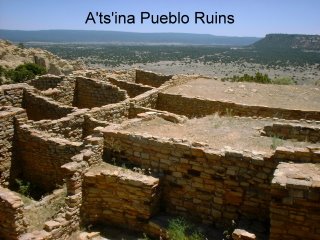 We were less than a mile from El Morro Natl Mon, which we visited several times. It has a very nice hiking trail, which wanders past many of the signatures carved in the famous Inscription Rock and then continues to the top of a large sandstone bluff with A'ts'ina Pueblo ruins and lovely views in all directions. There is a lovely natural pool at the base of the sandstone bluff, mentioned by Spanish explorers as early as 1583.
We were less than a mile from El Morro Natl Mon, which we visited several times. It has a very nice hiking trail, which wanders past many of the signatures carved in the famous Inscription Rock and then continues to the top of a large sandstone bluff with A'ts'ina Pueblo ruins and lovely views in all directions. There is a lovely natural pool at the base of the sandstone bluff, mentioned by Spanish explorers as early as 1583. 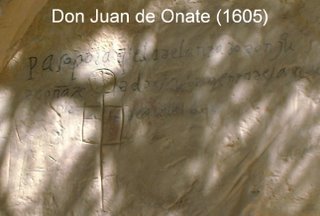 In 1605, the Spaniard Don Juan de Onate, perhaps inspired by the already-ancient petroglyphs, changed the sandstone face forever, carving an inscription of his discoveries for all to see.
In 1605, the Spaniard Don Juan de Onate, perhaps inspired by the already-ancient petroglyphs, changed the sandstone face forever, carving an inscription of his discoveries for all to see. 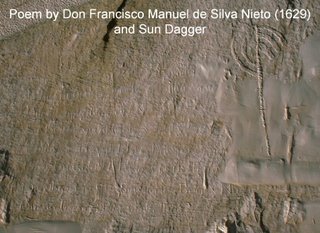 For the next 300+ years, passers-by from other Spanish explorers to US military expeditions to railroad crews have left their marks in the stone. Many US settlers added their names to the rock, and research has been done on many of them so you can know more about each person.
For the next 300+ years, passers-by from other Spanish explorers to US military expeditions to railroad crews have left their marks in the stone. Many US settlers added their names to the rock, and research has been done on many of them so you can know more about each person. 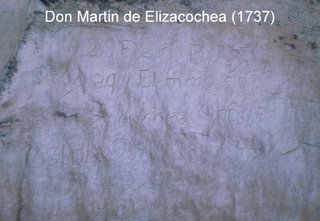 The first English inscription was made in 1849.
The first English inscription was made in 1849.We visited the nearby Zuni Pueblo and the A:shiwi (Zuni) A:wan Museum and Heritage Center to learn more about the Zuni culture & crafts. Zuni Pueblo is the largest of the 19 pueblos in NM, both in size (over 600 sq miles) & in population (over 11,000 residents). It is a traditional pueblo which maintains much of its traditional way of life, while also having more modern conveniences (electricity, running water, etc). We were able to walk through the pueblo and see the outside of the historic mission church.

The church is famed for its murals, but unfortunately it was not open the day we visited.

Another day we went to the Pueblo of Acoma (Sky City), called the "Oldest Continuously Inhabited City in the US". Archaeologists theorize the occupation of Acoma began between 800 and 1150 AD. The pueblo is built atop a large rock mesa almost 400 ft high, which originally had only one natural entrance, thus making it an ideal site for defense against enemies. The Acoma people mostly live nearby on the valley floor. Each member of the tribe has a house in the pueblo, which they can live in as much as they want to, but the mesa-top pueblo has no modern conveniences. Because of this, there are only 14 year-round families in residence out of 500 houses. Tribal members move to their mesa-top houses when festivals & religious ceremonies are held in the pueblo. San Esteban del Rey Mission was built in 1629, and the tour takes you into the mission. The only way to visit the pueblo is by guided tour, in which you are driven to the top of the mesa in a bus. At the end of the tour, you are allowed to walk down the natural "staircase" back to the tour center, which we considered a highlight of the tour. The road to the mesa-top was originally built in the 1960s by John Wayne, while filming on location. Interestingly enough, despite their prohibition of things modern in the historic pueblo, they allow filming of commercials & movies nearby.
 We visited various areas in the nearby El Malpais Natl Mon (NPS) and Natl Conservation Area (BLM). El Malpais lies between the tribal lands of the Zuni & Ramah Navajo to the west and the Acoma to the east. The area encompasses many interesting landscape features, predominantly huge lava fields. El Malpais means "the badlands", and it is pretty rough country. We visited La Ventana Arch, the largest of NM's natural arches, and stopped at several scenic overlooks on the eastern side of the area.
We visited various areas in the nearby El Malpais Natl Mon (NPS) and Natl Conservation Area (BLM). El Malpais lies between the tribal lands of the Zuni & Ramah Navajo to the west and the Acoma to the east. The area encompasses many interesting landscape features, predominantly huge lava fields. El Malpais means "the badlands", and it is pretty rough country. We visited La Ventana Arch, the largest of NM's natural arches, and stopped at several scenic overlooks on the eastern side of the area.  We went for a hike in the Big Tubes area, which is almost entirely on lava rock, both the rough very sharp aa rock (think of saying "ow-ow" as you walk on it!) and the smoother ropy pahoehoe type. The trail was marked with rock cairns, also made of lava rock, so it was quite a challenge to find the next marker. We walked beside huge cave entrances, collapsed lava tubes and natural bridges. There is a 17-mile-long system of lava tubes here, which we chose not to explore. Also near El Morro was the Candy Kitchen Wolf Rescue Ranch, founded as a rescue center for unwanted captive-bred wolves and wolfdogs.
We went for a hike in the Big Tubes area, which is almost entirely on lava rock, both the rough very sharp aa rock (think of saying "ow-ow" as you walk on it!) and the smoother ropy pahoehoe type. The trail was marked with rock cairns, also made of lava rock, so it was quite a challenge to find the next marker. We walked beside huge cave entrances, collapsed lava tubes and natural bridges. There is a 17-mile-long system of lava tubes here, which we chose not to explore. Also near El Morro was the Candy Kitchen Wolf Rescue Ranch, founded as a rescue center for unwanted captive-bred wolves and wolfdogs. 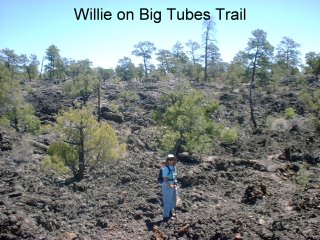 Two of the buildings served as headquarters for the Candy Kitchen Ranch, where pinon nut candy was made during the 1920s & 30s as a front for a bootlegger operation, the candy serving as an excuse for the large amounts of sugar needed to make the moonshine. We were taken on a tour of the ranch and got to see most of the 75 wolf/wolfdog inhabitants. Their mission, in addition to as much rescue as possible, is to educate the public on the wolf, the environment, responsible wolfdog ownership and the humane care & treatment of all animals. We were able to "meet" one wolf and actually pet him. It was somewhat sad, because there are so many unwanted wolfdogs in the US, and all the rescues are full. Many areas will not allow residents to keep wolfdogs, so they must be destroyed.
Two of the buildings served as headquarters for the Candy Kitchen Ranch, where pinon nut candy was made during the 1920s & 30s as a front for a bootlegger operation, the candy serving as an excuse for the large amounts of sugar needed to make the moonshine. We were taken on a tour of the ranch and got to see most of the 75 wolf/wolfdog inhabitants. Their mission, in addition to as much rescue as possible, is to educate the public on the wolf, the environment, responsible wolfdog ownership and the humane care & treatment of all animals. We were able to "meet" one wolf and actually pet him. It was somewhat sad, because there are so many unwanted wolfdogs in the US, and all the rescues are full. Many areas will not allow residents to keep wolfdogs, so they must be destroyed.